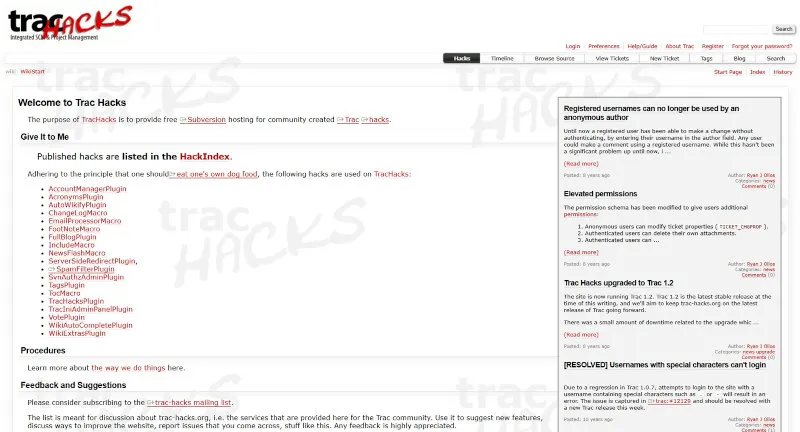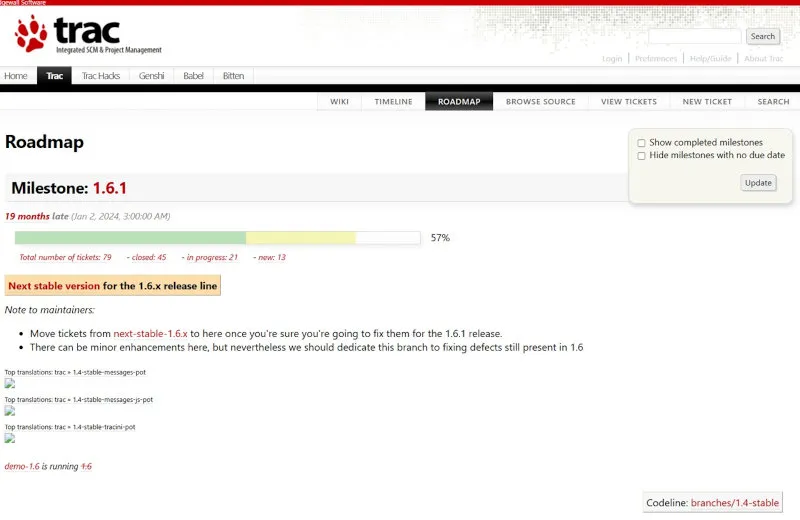
Trac: The Minimalist Issue Tracker and SCM Platform
Table of Contents
- Introduction
- Key Features at a Glance
- The Trac Philosophy: Who Is It For?
- GitHub vs. Trac: A Quick Comparison
- Pros and Cons
- Setting Up Trac: A Step-by-Step Guide
- Extending Trac with Plugins
- Use Cases and Success Stories
- Frequently Asked Questions (FAQ)
- Conclusion
- Getting Started & Further Reading
Introduction
Before the rise of monolithic DevOps platforms, there was a class of tools focused on doing a few things exceptionally well. Trac is a venerable and highly respected example of this philosophy. It is not merely a code host; it is an enhanced wiki and issue tracking system for software development projects, with deep integration for version control.
Written in Python and designed to be minimalist and extensible, Trac provides a simple, web-based way to manage projects. Its core idea is to create a seamless link between bug reports, tasks, wiki pages, and the code itself, providing context and history in a lightweight package. Since its inception in 2003 by Edgewall Software, Trac has been a go-to tool for open-source projects and small teams that prioritize simplicity and integration over feature-heavy platforms.
Key Features at a Glance
![]()
Trac’s strength lies in the tight integration of its core components, which are designed to create a holistic view of a project’s history and status.
| Feature | Description | Key Benefit |
|---|---|---|
| Integrated Issue Tracking | A simple but effective ticket system for managing bugs, tasks, and feature requests. | Tickets can be linked directly to code changesets, creating a clear and auditable path from a reported issue to its resolution in the code. |
| Integrated Wiki | A full-featured wiki where project documentation, notes, and requirements can be collaboratively edited. | Uses a simple syntax called “TracLinks” that allows you to effortlessly link between tickets, changesets, and other wiki pages, weaving a rich web of project knowledge. |
| VCS Browser | A source code browser that provides an interface to repositories, with first-class support for Subversion (SVN) and support for Git and others. | Allows you to browse files, view changesets, and see diffs directly in the web UI, all hyperlinked with the issue tracker and wiki. |
| Timeline View | A chronological, reverse-ordered stream of all project events—wiki edits, new tickets, closed tickets, and code commits. | Provides a single, at-a-glance dashboard to see all recent activity across the entire project. |
| Customizable Workflows | Configurable ticket workflows to match your team’s process. | Allows teams to define custom states and transitions for tickets, aligning with agile, Kanban, or other methodologies. |
| Permission System | Fine-grained permissions to control access to features and data. | Ensures team members have appropriate access levels, enhancing security and collaboration. |
The Trac Philosophy: Who Is It For?

Trac is built on a philosophy of minimalism, integration, and developer-centric project management. It believes that the project’s documentation (the wiki) and its tasks (the issue tracker) are the central artifacts, which are then “enlightened” by the code.
This makes it an ideal choice for:
Projects with a long history, especially in SVN: Many long-running open-source projects started on Trac with Subversion and continue to use it effectively.
Teams that value simplicity and low overhead: Trac is extremely lightweight and can run on minimal hardware, making it perfect for small teams or personal projects.
Documentation-heavy projects: The tight integration of the wiki with the code and tickets makes it a superb tool for projects where documentation is a first-class citizen.
Academic and Research Environments: Its simplicity and self-hosted nature make it easy to deploy for managing research projects and collaborations.
Teams with custom workflows: Trac’s customizable ticket workflows allow teams to tailor the tool to their specific processes.
If you believe a project management tool should be simple, fast, and stay out of your way, Trac embodies that ideal.
GitHub vs. Trac: A Quick Comparison
The core premise of GitHub and Trac are fundamentally different, representing different eras of development tooling.
| Aspect | GitHub | Trac |
|---|---|---|
| Primary Focus | A developer platform centered around the Git repository. | A project management system centered around the wiki and issue tracker. |
| Hosting Options | Cloud (SaaS) and Self-hosted (Enterprise). | Self-hosted only. |
| CI/CD | Fully integrated, powerful GitHub Actions. | No built-in CI/CD. Relies on external tools and post-commit hooks. |
| Core Experience | A social, collaborative platform for code. | A utilitarian, functional tool for project information management. |
| Version Control | Native Git support. | Native Subversion support with Git as a secondary option. |
| Community | Massive, social-coding community with public repositories. | Smaller, focused community, primarily for self-hosted projects. |
Pros and Cons

Why You Might Choose Trac
Extremely Lightweight: Trac has a very small resource footprint and can be run on modest hardware, a stark contrast to resource-hungry platforms like GitLab.
Superb Wiki and Ticket Integration: The “TracLinks” system that connects every part of the project is intuitive and powerful, creating a deeply interconnected knowledge base.
Simple and Focused: It does not suffer from feature bloat. It provides the essential tools for project management and gets out of the way.
Highly Extensible: As a mature Python project, it has a large library of third-party plugins (available on TracHacks) to add specific functionality.
Cost-Effective: Being open-source and self-hosted, Trac incurs no subscription costs, ideal for budget-conscious teams.
Potential Drawbacks
Dated User Interface: The UI is functional but looks and feels dated compared to modern web applications. This can be a significant hurdle for new users.
No Built-in CI/CD: This is a major gap for modern development workflows. Integrating CI/CD requires manual configuration with external tools like Jenkins.
Git is Not the Primary Focus: While Git is supported, Trac’s heart and soul are in the Subversion workflow. The integration with Git can sometimes feel less seamless than with SVN.
Self-Hosting is Required: You are responsible for everything: installation, configuration, security, and maintenance, which requires system administration skills.
Limited Mobile Support: Trac’s web interface is not optimized for mobile devices, which can be a drawback for teams working on the go.
Setting Up Trac: A Step-by-Step Guide
Setting up Trac is straightforward but requires some system administration knowledge. Below is a basic guide to get you started on a Linux-based system (e.g., Ubuntu).
-
Install Dependencies
Trac requires Python (2.7 or 3.x), a web server (e.g., Apache or Nginx), and a version control system (e.g., Subversion or Git). For example, on Ubuntu:sudo apt update sudo apt install python3 python3-pip apache2 libapache2-mod-wsgi-py3 subversion -
Install Trac
Use pip to install Trac:
pip3 install trac -
Create a Trac Environment
A Trac environment is a directory containing your project’s configuration, database, and files. Create one with:trac-admin /path/to/trac-environment initenvFollow the prompts to set the project name, database (SQLite is default), and repository type (e.g., SVN or Git).
-
Configure the Web Server
For Apache, configure mod_wsgi to serve Trac. Create a configuration file (e.g.,/etc/apache2/sites-available/trac.conf):<VirtualHost *:80> ServerName trac.example.com WSGIScriptAlias /trac /path/to/trac-environment/cgi-bin/trac.wsgi <Directory /path/to/trac-environment/cgi-bin> WSGIApplicationGroup %{GLOBAL} Require all granted </Directory> </VirtualHost> Enable the site and restart Apache: ```bash sudo a2ensite trac sudo systemctl restart apache2 -
Access Trac
Open your browser and navigate tohttp://trac.example.com/trac. Log in with the admin account you set up during initialization. -
Optional: Configure Plugins
Install plugins from TracHacks to extend functionality, such as Git support or advanced reporting.
Tip: Always secure your Trac instance with HTTPS and proper authentication to protect sensitive project data.
Extending Trac with Plugins
Trac’s extensibility is one of its strongest features. The TracHacks repository hosts a wide range of plugins to enhance functionality. Some popular plugins include:
GitPlugin: Adds robust Git support, improving integration for Git-based projects.
Agilo for Scrum: Adds Scrum and Agile project management features, including sprint planning and burndown charts.
TracXMLRPC: Enables remote access to Trac’s features via XML-RPC, useful for integrating with IDEs or scripts.
Custom Workflow Plugins: Allow for advanced ticket workflow customization, such as adding states like “In Review” or “Blocked.”
To install a plugin, download it from TracHacks and use pip or place it in the plugins directory of your Trac environment. Then, update the trac.ini configuration file to enable the plugin.
Use Cases and Success Stories

Trac has been a cornerstone for many open-source projects and academic collaborations. Some notable examples include:
Apache Software Foundation: Several Apache projects, such as Subversion itself, have used Trac for issue tracking and documentation due to its seamless SVN integration.
Python Projects: Trac’s Python roots make it a natural fit for Python-based projects, such as early versions of Django and Twisted.
Academic Research: Universities and research groups use Trac to manage collaborative projects, leveraging its wiki for documentation and ticket system for task tracking.
For example, a research team at a university might use Trac to manage a multi-year project, with the wiki serving as a central repository for papers, datasets, and protocols, while tickets track tasks like code development or experiment milestones.
Frequently Asked Questions (FAQ)
Q: Can Trac be used with modern Git-based workflows?
A: Yes, Trac supports Git through plugins like GitPlugin, but its integration is not as seamless as with Subversion. For Git-heavy teams, additional configuration may be needed.
Q: Is Trac suitable for large teams?
A: Trac is best suited for small to medium-sized teams due to its lightweight nature and lack of built-in CI/CD. Large teams may find it lacking in scalability compared to platforms like GitLab.
Q: How does Trac handle permissions?
A: Trac has a fine-grained permission system, allowing you to assign roles (e.g., developer, admin) and control access to tickets, wiki pages, and repositories.
Q: Can Trac be hosted in the cloud?
A: Trac is self-hosted, but you can deploy it on cloud providers like AWS, Azure, or DigitalOcean. You’ll need to manage the server and security yourself.
Q: Are there mobile apps for Trac?
A: No official mobile apps exist, and the web interface is not optimized for mobile. Some teams use third-party tools or custom scripts to access Trac via APIs.
Q: How does Trac compare to Jira?
A: Trac is simpler and more lightweight than Jira, focusing on wiki and ticket integration rather than Jira’s extensive project management and reporting features. Trac is better for small, documentation-focused teams, while Jira suits complex enterprise workflows.
Conclusion
Trac is a throwback to a simpler era of software development tooling, and that is its greatest strength. It is not a direct competitor to GitHub for teams looking for a modern, feature-rich DevOps platform. Instead, it remains an excellent choice for a specific niche: teams that need a lightweight, self-hosted, and deeply integrated system for managing issues and documentation, especially those with a history in Subversion. Its minimalist design, extensibility through plugins, and focus on integration make it a timeless tool for the right audience. Whether you’re running a small open-source project, a research collaboration, or a documentation-heavy initiative, Trac proves that sometimes, less is more.
Getting Started & Further Reading
Ready to explore this classic project management tool? You can find all the official resources here.
Official Website: https://trac.edgewall.org/
Documentation (The Trac Guide): https://trac.edgewall.org/wiki/TracGuide
Plugin and Extension Repository: https://trachacks.org/
Mailing List & Community: https://trac.edgewall.org/wiki/MailingList